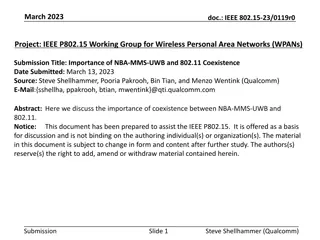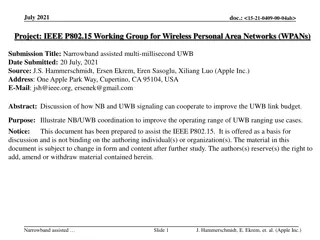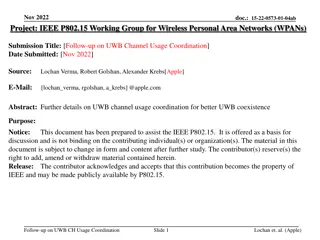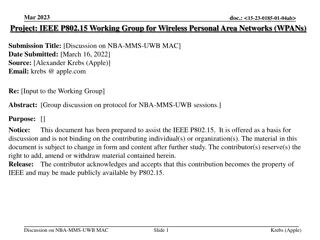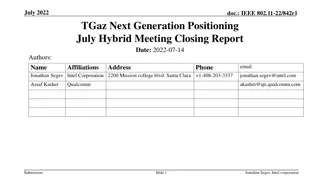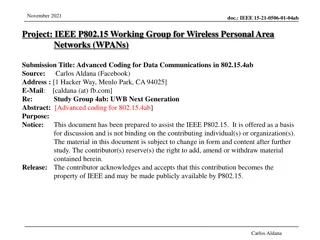Overview of IEEE 802.15.4ab - Next Generation UWB
An overview of the IEEE 802.15.4ab focusing on next-generation Ultra-Wideband (UWB) technology, specifically the narrowband/UWB hybrid proposals and coexistence with other services. The document explores the enhancements to UWB physical layers, medium access control, and ranging techniques while maintaining compatibility with enhanced ranging capable devices.
Download Presentation

Please find below an Image/Link to download the presentation.
The content on the website is provided AS IS for your information and personal use only. It may not be sold, licensed, or shared on other websites without obtaining consent from the author. Download presentation by click this link. If you encounter any issues during the download, it is possible that the publisher has removed the file from their server.
E N D
Presentation Transcript
July 2022 July 2022 doc.: IEEE 802.11-22/1081r0 Overview of 802.15.4ab Date: 2022-07-12 Authors: Name Company Address Phone email Los Gatos, CA Benjamin Rolfe Blind Creek Associates <deprecated> Ben.Rolfe@ieee.org Contribution Slide 1 Benjamin Rolfe (Blind Creek Associates)
July 2022 July 2022 doc.: IEEE 802.11-22/1081r0 Abstract An overview of amendment 802.15.4ab: Next Generation UWB With a focus on the narrow band/UWB hybrid proposals and coexistence with other services Contribution Slide 2 Benjamin Rolfe (Blind Creek Associates)
doc.: IEEE 802.11-22/1081r0 July 2022 Task Group 15.4ab Next Generation UWB Amendment to IEEE Std 802.15.4 Objective: enhancements to 802.15.4 Ultra Wideband (UWB) physical layers (PHYs) medium access control (MAC) and associated ranging techniques while retaining backward compatibility with enhanced ranging capable devices (ERDEVs). Contribution Slide 3 Benjamin Rolfe (Blind Creek Associates)
doc.: IEEE 802.11-22/1081r0 July 2022 A Brief history of time ok just 802.15.4 UWB 2006: IEEE 802.15.4 first published in 2003 and first revision in 2006 2007: IEEE 802.15.4a introduced UWB PHY and related MAC enhancements One impulse radio PHY, currently known as High Repetition Pulse (HRP) Adopted in a variety of applications Channel plans for 3.1 to 5 GHz and 6 to 10.3 GHz Moderately widely used in specialty applications requiring high precision ranging and real time location tracking including industrial, commercial and military applicaitons 2012: IEEE 802.15.4f introduced a new low pulse repetition (LRP) PHY Focused on RFID applications Channel plan for 6 to 8.5 GHz Widely used for tracking and location in manufacturing and other industries Contribution Slide 4 Benjamin Rolfe (Blind Creek Associates)
doc.: IEEE 802.11-22/1081r0 July 2022 A Brief history of time ok just 802.15.4 UWB 2020: IEEE 802.15.4z Enhanced UWB Enhanced both HRP and LRP PHYs HRP channel plan same as 802.15.4a LRP channel plan extended up to 10 GHz Widely deployed (billions) in consumer devices (smart phones), vehicle entry systems, location tracking and navigation applications of all kinds, and growing rapidly Included features to assure coexistence with legacy UWB 2021: Task Group 15.4ab created to address the next generation of UWB enhancements Building upon 15.4a, 15.4f, 15.4z Feedback from multiple industry groups using the standard Based on real world experience Further enhancing coexistence (with everything) is a project goal (priority) Contribution Slide 5 Benjamin Rolfe (Blind Creek Associates)
doc.: IEEE 802.11-22/1081r0 July 2022 5.2.b Scope of the project (As approved): This amendment enhances the Ultra Wideband (UWB) physical layers (PHYs) medium access control (MAC), and associated ranging techniques while retaining backward compatibility with enhanced ranging capable devices (ERDEVs). Areas of enhancement include: additional coding, preamble and modulation schemes to additional coding, preamble and modulation schemes to support improved link budget and/or reduced air-time relative to IEEE Std 802.15.4 UWB; additional channels and operating frequencies; interference mitigation techniques to support greater device density and higher traffic use cases relative to the IEEE Std 802.15.4 UWB; improvements to accuracy, precision and reliability and interoperability for high-integrity ranging; schemes to reduce complexity and power consumption; definitions for tightly coupled hybrid operation with narrowband signaling to assist UWB; enhanced native discovery and connection setup mechanisms; sensing capabilities to support presence detection and environment mapping; and mechanisms supporting low-power low-latency streaming as well as high data-rate streaming allowing at least 50 Mb/s of throughput. Support for peer-to-peer, peer-to-multi-peer, and station-to-infrastructure protocols are in scope, as are infrastructure synchronization mechanisms. This amendment includes safeguards so that the high throughput data use cases do not cause significant disruption to low duty-cycle ranging use cases. https://development.standards.ieee.org/myproject-web/app#viewpar/9081 Contribution Slide 6 Benjamin Rolfe (Blind Creek Associates)
doc.: IEEE 802.11-22/1081r0 July 2022 What is it Amendment 4ab is a work in progress Existing 802.15.4 PHYs cover all sorts of bands UWB in 3.1 to 5, 6 to 10.6 (published in 2007) Narrow band PHYs (many) in sub 1GHz, 2.4 GHz and many other bands Already coexist in several bands with 802.11 What s been proposed in a nutshell Coupling NB with UWB cooperatively Improved coexistence mechanisms New channel plans for existing PHYs to support the above Some enhancements to existing PHYs to improve coexistence Contribution Slide 7 Benjamin Rolfe (Blind Creek Associates)
doc.: IEEE 802.11-22/1081r0 A map of the P802.15.4ab enhancements HPRF Mode Data Enhancements Improved TWR, (TOA, AOA) Wake-up Radio Multi-ms data mode Channel Access NEW HPRF MODE DATA RATES DATA CODING Existing: 7.8 Mb/s (@ 124.8 MHz PRF) 31.2 Mb/s (@ 249.62 MHz PRF) Existing: NB CCA & channel mirroring Fragment for Timing Acquisition New CCA CSMA mode K=7 convolutional code 37 nJ fragment for TWR Tightly coupled narrowband assist Lower: 3.9 Mb/s, 1.95 Mb/s, 975 kb/s Intermediary: 15.6 Mb/s Adding: advanced code LDPC (lead candidate) MAC: Uses for NB Mult-Frag Multi-ms Ranging Higher: 62.4 Mb/s, 124.8 Mb/s NB datacomms for TWR control & data Other Datacomms New PHR ? MAC: New HRP modulation targeting non-coherent demodulation SYNC, SFD, PHR, Data 20.8 MHz symbol rate Independent Peer User Network Synchronisation User network separation Sensing Sensing Code Sequence Preamble / Timestamp Sequence CZC Codes MAC: CIR Signalling m-sequences Pulse Shape Modulation timing Ipatov Codes Chip Rate change New Frequency Sub-Channels Golay Codes SZC codes Chip Rate + Carrier Frequency change Pseudo Random Code Utility of codes? Contribution
doc.: IEEE 802.11-22/1081r0 A map of the P802.15.4ab enhancements HPRF Mode Data Enhancements Improved TWR, (TOA, AOA) Wake-up Radio Multi-ms data mode Channel Access NEW HPRF MODE DATA RATES DATA CODING Existing: 7.8 Mb/s (@ 124.8 MHz PRF) 31.2 Mb/s (@ 249.62 MHz PRF) Existing: NB CCA & channel mirroring Fragment for Timing Acquisition New CCA CSMA mode K=7 convolutional code 37 nJ fragment for TWR Tightly coupled narrowband assist Lower: 3.9 Mb/s, 1.95 Mb/s, 975 kb/s Intermediary: 15.6 Mb/s Adding: advanced code LDPC (lead candidate) MAC: Uses for NB Mult-Frag Multi-ms Ranging Higher: 62.4 Mb/s, 124.8 Mb/s NB datacomms for TWR control & data Other Datacomms New PHR ? MAC: New HRP modulation targeting non-coherent demodulation SYNC, SFD, PHR, Data 20.8 MHz symbol rate Independent Peer User Network Synchronisation User network separation Sensing Sensing Code Sequence Preamble / Timestamp Sequence CZC Codes MAC: CIR Signalling m-sequences Pulse Shape Modulation timing Ipatov Codes Chip Rate change New Frequency Sub-Channels Golay Codes SZC codes Chip Rate + Carrier Frequency change Pseudo Random Code Utility of codes? Contribution
doc.: IEEE 802.11-22/1081r0 July 2022 802.15.4 MAC Simple and flexible MAC architecture Optimized for lower duty cycle and activity factors Optimized to provide a lot of gaps (time domain) Includes CSMA Multiple CSMA options Multiple CCA methods including Energy above Threshold (ED) Available for all PHYs NB PHYs under consideration typically will use CSMA Considering CSMA enhancements under consideration specifically to improve coexistence with other services Contribution Slide 10 Benjamin Rolfe (Blind Creek Associates)
doc.: IEEE 802.11-22/1081r0 July 2022 15.4 Channel Access CSMA-CA includes multiple variations Unslotted CSMA-CA (most common) Slotted CSMA-CA defined Non-persistent CSMA Various scheduled access schemes Some with CSMA-CA (useful) TS without CSMA-CA (less used) Contribution Slide 11 Benjamin Rolfe (Blind Creek Associates)
doc.: IEEE 802.11-22/1081r0 July 2022 Clear Channel Assessment Multiple CSMA-CA modes including preamble detect, energy detect and Aloha equivalent Many different PHYs Meaning of preamble means differs PHY to PHY ED is fairly consistent but ED threshold varies by PHY Common implementation of ED includes variable threshold and duration capability always clear mode (mode 4) Typically preferred for very low duty cycle operations Commonly used with UWB PHYs due to both low duty cycles and challenge in sensing a UWB channel as busy New CCA modes Work in TG4ab focused on CAA that works reliably with UWB signals Work also in CCA to better coexist with different services (e.g. 802.11) Contribution Slide 12 Benjamin Rolfe (Blind Creek Associates)
doc.: IEEE 802.11-22/1081r0 July 2022 Channelization Several options under discussion - This is a work in progress Low data volumes and very low activity and duty factors U-NII bands (upper 5 GHz) under consideration Upper 5 GHz U-NII attractive due to ability to share signal path with UWB at 6 GHz Generally better behavior than 2.4 GHz Good coexistence with 802.11 is a primary goal The point is better reliability (less interference) Contribution Slide 13 Benjamin Rolfe (Blind Creek Associates)
doc.: IEEE 802.11-22/1081r0 July 2022 List of references: Some relevant technical contributions Title URL https://mentor.ieee.org/802.15/dcn/22/15-22-0386-00-04ab-narrow-band-mirroring- channels.docx https://mentor.ieee.org/802.15/dcn/22/15-22-0383-00-04ab-nb-assisted-uwb-channel-access- follow-up.pptx https://mentor.ieee.org/802.15/dcn/22/15-22-0340-01-04ab-narrowband-channel-access-and- interference-mitigation-for-nba-mms-uwb.pptx https://mentor.ieee.org/802.15/dcn/22/15-22-0339-01-04ab-narrowband-channel-allocation- for-nba-mms-uwb.pptx https://mentor.ieee.org/802.15/dcn/22/15-22-0372-00-04ab-uwb-interference- considerations.pptx https://mentor.ieee.org/802.15/dcn/22/15-22-0358-00-04ab-coexistence-with-wi-fi-by-using- narrowband-mirroring-channel.pptx https://mentor.ieee.org/802.15/dcn/22/15-22-0340-00-04ab-narrowband-channel-access-and- interference-mitigation-for-nba-mms-uwb.pptx https://mentor.ieee.org/802.15/dcn/22/15-22-0339-00-04ab-narrowband-channel-allocation- for-nba-mms-uwb.pptx Narrow Band Mirroring channels NB-assisted UWB channel access follow-up Narrowband Channel Access and Interference Mitigation for NBA-MMS-UWB Narrowband Channel Allocation for NBA-MMS-UWB UWB Interference Considerations Coexistence with Wi-Fi by using Narrowband Mirroring Channel Narrowband Channel Access and Interference Mitigation for NBA-MMS-UWB Narrowband Channel Allocation for NBA-MMS-UWB A map of 4ab enhancements https://mentor.ieee.org/802.15/dcn/22/15-22-0316-01-04ab-a-map-of-4ab-enhancements.pptx https://mentor.ieee.org/802.15/dcn/22/15-22-0305-00-04ab-a-summary-of-proposals-and- interests.pptx https://mentor.ieee.org/802.15/dcn/22/15-22-0276-02-04ab-details-of-nb-mirroring- channel.pptx A summary of proposals and interests Details of NB Mirroring Channel Contribution Slide 14 Benjamin Rolfe (Blind Creek Associates)
doc.: IEEE 802.11-22/1081r0 July 2022 List of references: Some relevant technical contributions https://mentor.ieee.org/802.15/dcn/22/15-22-0275-00-04ab-proposal-of-nb-phy-assisted-cca-for-uwb- medium-access.docx https://mentor.ieee.org/802.15/dcn/22/15-22-0266-00-04ab-discussion-on-nb-assisted-uwb-message- sequence-and-synchronization.pptx https://mentor.ieee.org/802.15/dcn/22/15-22-0261-00-04ab-coexistence-discussion-on-nb-assisted- uwb.pptx Proposal of NB PHY assisted CCA for UWB medium access Discussion on NB assisted UWB message sequence and synchronization Coexistence discussion on NB assisted UWB Review of UWB Coex Contributions https://mentor.ieee.org/802.15/dcn/22/15-22-0242-00-04ab-review-of-uwb-coex-contributions.pptx Recap of Narrowband / UWB Coupling MAC https://mentor.ieee.org/802.15/dcn/22/15-22-0180-00-04ab-recap-of-narrowband-uwb-coupling-mac.pptx https://mentor.ieee.org/802.15/dcn/22/15-22-0174-01-04ab-u-nii-band-status-of-japan-for-consideration-to- nb-assisted-uwb.pptx https://mentor.ieee.org/802.15/dcn/22/15-22-0156-00-04ab-discussion-on-nb-assisted-uwb.pptx https://mentor.ieee.org/802.15/dcn/22/15-22-0076-00-04ab-proposal-for-extending-nb-uwb-for-secure- ranging.ppt https://mentor.ieee.org/802.15/dcn/22/15-22-0065-00-04ab-pilot-nb-radio-for-assisting-uwb-channel- access.pptx U-NII band status of Japan for consideration to NB-assisted UWB Discussion on NB assisted UWB Proposal for extending NB-UWB for secure ranging Pilot NB radio for assisting UWB channel access Potentials of narrowband assisted UWB https://mentor.ieee.org/802.15/dcn/22/15-22-0064-00-04ab-potentials-of-narrowband-assisted-uwb.pptx https://mentor.ieee.org/802.15/dcn/21/15-21-0589-00-04ab-uwb-channel-access-aided-by-pilot-narrow- band-radio.pptx https://mentor.ieee.org/802.15/dcn/21/15-21-0292-00-04ab-opportunities-for-improved-uwb-nb- coordination.pptx https://mentor.ieee.org/802.15/dcn/21/15-21-0289-00-04ab-coupling-between-nb-and-uwb.pptx UWB channel access aided by pilot narrow band radio Opportunities for improved UWB/NB coordination Coupling between NB and UWB Contribution Slide 15 Benjamin Rolfe (Blind Creek Associates)






